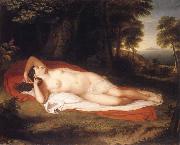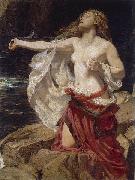Wholesale Oil Painting Reproductions No Minimum and Door to Door! |
|||||||||||
|
|
|||||||||||

|
|||||||||||
|
|
|
||||||||
All John Vanderlyn Oil Paintings |
||||||||
|
|
||||||||
|
|
||||||||
|
Artist Introduction: 1775-1852
John Vanderlyn (October 18, 1775 ?C September 23, 1852) was a American neoclassicist painter, was born at Kingston, New York.
He was employed by a print-seller in New York, and was first instructed in art by Archibald Robinson (1765-1835), a Scotsman who was afterwards one of the directors of the American Academy. He went to Philadelphia, where he spent time in the studio of Gilbert Stuart and copied some of Stuart's portraits, including one of Aaron Burr, who placed him under Gilbert Stuart as a pupil.
He was a proteg?? of Aaron Burr who in 1796 sent Vanderlyn to Paris, where he studied for five years. He returned to the United States in 1801 and lived in the home of Burr, then the Vice President, where he painted the well-known likeness of Burr and his daughter. In 1802 he painted two views of Niagara Falls, which were engraved and published in London in 1804. He returned to Paris in 1803, also visiting England in 1805, where he painted the Death of Miss McCrea for Joel Barlow. Vanderlyn then went to Rome, where he painted his picture of Marius amid the Ruins of Carthage, which was shown in Paris, and obtained the Napoleon gold medal there. This success caused him to remain in Paris for seven years, during which time he prospered greatly. In 1812 he showed a nude Ariadne (engraved by Durand, and now in the Pennsylvania Academy), which increased his fame. When Aaron Burr fled to Paris, Vanderlyn was for a time his only support.
Vanderlyn returned to the United States in 1815, and painted portraits of various eminent men, including Washington (for the U.S. House of Representatives), James Monroe, John C. Calhoun, Governor Joseph C. Yates, Governor George Clinton, Andrew Jackson, and Zachary Taylor. He also exhibited panoramas and had a "Rotunda" built in New York City which displayed panoramas of Paris, Athens, Mexico, Versailles (by himself), and some battle-pieces; but neither his portraits nor the panoramas brought him financial success, partly because he worked very slowly.
In 1842, through friendly influences, he was commissioned by Congress to paint The Landing of Columbus. Going to Paris, he hired a French artist, who, it is said, did most of the work. It was engraved for the United States five-dollar banknotes. He died in poverty at Kingston, New York, on 23 September 1852.
Vanderlyn was the first American to study in France instead of in England, and to acquire accurate draughtsmanship. He was more academic than his fellows; but, though faithfully and capably executed, his work was rather devoid of charm, according to the 1911 Encyclopaedia Britannica. His Landing of Columbus has been called (by Appleton's Cyclopedia) "hardly more than respectable."
His other works include portraits of Monroe, and Robert R Livingston (New York Historical Society). |
||||||||
|
|
||||||||
|
Ariadne Painting ID:: 51348 |
mk218
c.1831-35
Oil on canvas
43.5x49.2cm
|
|||||||
Height Width |
INS/CM Quality |
|||||||
|
X |
| |||||||
|
|
||||||||
All Herbert James Draper Oil Paintings |
||||||||
|
|
||||||||
|
|
||||||||
|
Artist Introduction: (1863 - 22 September 1920) was an English Classicist painter whose career began in the Victorian era and extended through the first two decades of the 20th century.
Born in London, the son of a jeweller named Henry Draper and his wife Emma,he was educated at Bruce Castle school in Tottenham and then went on to study art at the Royal Academy. He undertook several educational trips to Rome and Paris between 1888 and 1892, having won the Royal Academy Gold Medal and Travelling Studentship in 1889. In the 1890s he worked also as an illustrator, settling in London. In 1891 he married his wife Ida , with whom he had a daughter, Yvonne.He died of arteriosclerosis at his home at 15, Abbey Road, N.W.8 on 22 September 1920 |
||||||||
|
|
||||||||
|
|
Ariadne Painting ID:: 92089 |
Oil on canvas, 100 by 77cm, circ. 1905
cjr |
||||||
Height Width |
INS/CM Quality |
|||||||
|
X |
| |||||||
|
|
||||||||
|
Prev Next
|
||||||||
|
|
||||||||
|
Related Paintings to Herbert James Draper :. |
||||||||
|
|
||||||||
|
CONTACT US |


